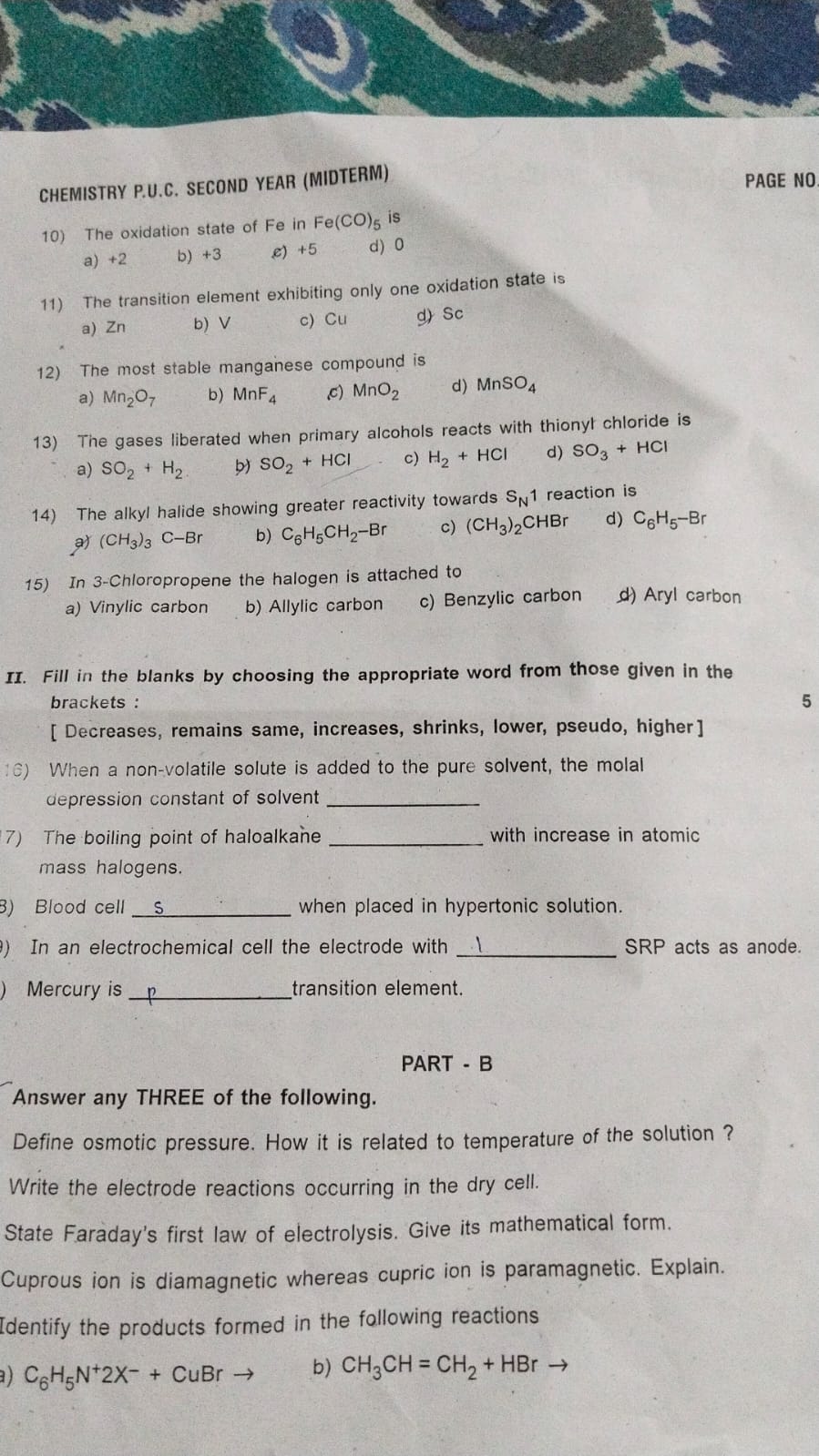1. The oxidation state of Fe in Fe(CO)5 is: a) +2 b) +3 c) +5 d) 0. 2. The transition element exhibiting only one oxidation state is: a) Zn b) V c) Cu d) Sc. 3. The most stable man... 1. The oxidation state of Fe in Fe(CO)5 is: a) +2 b) +3 c) +5 d) 0. 2. The transition element exhibiting only one oxidation state is: a) Zn b) V c) Cu d) Sc. 3. The most stable manganese compound is: a) Mn2O7 b) MnF4 c) MnO2 d) MnSO4. 4. The gases liberated when primary alcohols react with thionyl chloride is: a) SO2 + H2 b) SO2 + HCl c) H2 + HCl d) SO3 + HCl. 5. The alkyl halide showing greater reactivity towards SN1 reaction is: a) (CH3)3C-Br b) C6H5CH2-Br c) (CH3)2CHBr d) C6H5-Br. 6. In 3-Chloropropene the halogen is attached to: a) Vinylic carbon b) Allylic carbon c) Benzylic carbon d) Aryl carbon. Fill in the blanks by choosing the appropriate word from those given in the brackets: [ Decreases, remains same, increases, shrinks, lower, pseudo, higher ] 1. When a non-volatile solute is added to the pure solvent, the molal depression constant of solvent ____________. 2. The boiling point of haloalkane ____________ with increase in atomic mass halogens. 3. Blood cell ____________ when placed in hypertonic solution. 4. In an electrochemical cell the electrode with ____________ SRP acts as anode. 5. Mercury is ____________ transition element. Part B: Answer any THREE of the following. 1. Define osmotic pressure. How is it related to temperature of the solution? 2. Write the electrode reactions occurring in the dry cell. 3. State Faraday's first law of electrolysis. Give its mathematical form. 4. Cuprous ion is diamagnetic whereas cupric ion is paramagnetic. Explain. 5. Identify the products formed in the following reactions: a) C6H5N+2X- + CuBr → b) CH3CH = CH2 + HBr →

Understand the Problem
The question is a chemistry exam paper containing multiple-choice questions, fill-in-the-blank questions, and open-ended questions related to chemical properties, reactions, and concepts such as osmotic pressure and Faraday's laws. It tests knowledge in various areas of chemistry.
Answer
["1. 0","2. Zn","3. MnO2","4. SO2 + HCl","5. (CH3)3C-Br","6. Allylic","Blanks: remains same, increases, shrinks, lower, pseudo"]
["1. The oxidation state of Fe in Fe(CO)5 is 0.","2. The transition element exhibiting only one oxidation state is Zn.","3. The most stable manganese compound is MnO2.","4. The gases liberated when primary alcohols react with thionyl chloride are SO2 and HCl.","5. The alkyl halide showing greater reactivity towards SN1 reaction is (CH3)3C-Br.","6. In 3-Chloropropene, the halogen is attached to an allylic carbon.","Fill in the blanks: 1) remains same, 2) increases, 3) shrinks, 4) lower, 5) pseudo."]
Answer for screen readers
["1. The oxidation state of Fe in Fe(CO)5 is 0.","2. The transition element exhibiting only one oxidation state is Zn.","3. The most stable manganese compound is MnO2.","4. The gases liberated when primary alcohols react with thionyl chloride are SO2 and HCl.","5. The alkyl halide showing greater reactivity towards SN1 reaction is (CH3)3C-Br.","6. In 3-Chloropropene, the halogen is attached to an allylic carbon.","Fill in the blanks: 1) remains same, 2) increases, 3) shrinks, 4) lower, 5) pseudo."]
More Information
Fe(CO)5 is a neutral complex where carbonyl groups do not impact the oxidation number. Zinc's stable +2 state is due to its fully filled d-subshell.
Tips
Remember that ligands like CO are neutral, affecting the oxidation number calculations.
Sources
- Oxidation States of Transition Metals - Chemistry LibreTexts - chem.libretexts.org
- Calculate oxidation number of central atom in [Fe(CO)5] - Toppr - toppr.com